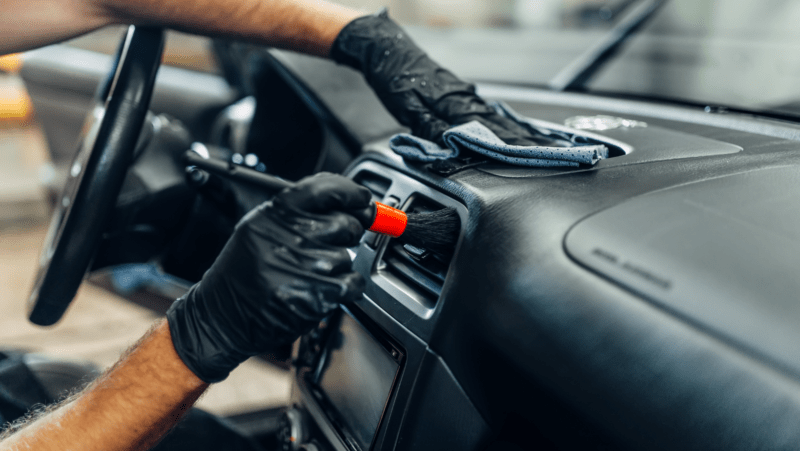The Most Common Car Cleaning Mistakes (and How to Avoid Them)

Keeping your car clean is essential not only for its appearance but also for its long-term maintenance. However, even with the best intentions, many car owners make common mistakes when cleaning their vehicles. These mistakes can lead to scratches, paint damage, and even reduce the value of your car over time. In this blog, we’ll explore the most common car cleaning mistakes, explain why they’re harmful, and provide tips on how to avoid them to keep your car in top condition.
1. Using Dish Soap or Household Cleaners
One of the most frequent car cleaning mistakes is using dish soap or other household cleaners on the car’s exterior. While dish soap is great for cutting through grease on dishes, it’s far too harsh for your car’s paint and can strip away protective layers like wax or sealants.
Why it’s a problem:
- Strips Protection: Dish soap is designed to break down grease, and in doing so, it can strip away the protective wax or sealant on your car’s paint, leaving it vulnerable to damage from the elements.
- Harsh Chemicals: Household cleaners may contain harsh chemicals that can degrade the paint over time, leading to fading or dullness.
What to do instead: Use a pH-balanced car wash soap specifically designed for automotive paint. These products are gentle yet effective, providing a thorough clean without damaging your car’s paint or protective coatings.
2. Not Using the Two-Bucket Method
If you’re washing your car with just one bucket of water, you’re making a critical mistake. The problem is that as you clean, dirt and grit from your car collect in the water, and when you dip your wash mitt back into the bucket, you’re reapplying that dirt to the surface, which can cause scratches and swirl marks.
Why it’s a problem:
- Risk of Scratches: Reusing dirty water can lead to fine scratches and swirls in your car’s paint as you unknowingly grind dirt and grit against the surface.
What to do instead: Use the two-bucket method: one bucket for soapy water and another for rinsing your wash mitt. After each pass on your car’s surface, rinse the mitt in the clean water before reloading it with soap. This reduces the risk of transferring dirt back onto the car.
3. Using a Dirty or Cheap Sponge
A dirty or low-quality sponge can be abrasive to your car’s paint, causing micro-scratches that dull the surface over time. Cheap sponges tend to trap dirt and grit, which can then act like sandpaper as you clean your car.
Why it’s a problem:
- Micro-Abrasions: Sponges, especially old or low-quality ones, are prone to trapping dirt and debris, which can scratch the paint during washing.
- Uneven Cleaning: Cheap sponges may not spread soap evenly, resulting in a patchy clean.
What to do instead: Invest in a high-quality microfiber wash mitt or a soft lamb’s wool mitt. These tools are designed to lift dirt away from the paint and are much gentler on your car’s surface.
4. Letting Water Air Dry
After washing your car, it’s tempting to let it air dry naturally, especially on a warm day. However, air drying can lead to water spots, which are mineral deposits left behind when the water evaporates. These spots can be difficult to remove and, over time, can etch into the clear coat.
Why it’s a problem:
- Water Spots: Air drying leaves behind mineral deposits that can cause unsightly water spots, which are especially noticeable on dark-colored cars.
- Clear Coat Damage: Over time, these spots can become etched into the clear coat, requiring professional polishing to remove.
What to do instead: Use a clean microfiber drying towel or a chamois to dry your car immediately after washing. For best results, blot the water rather than wiping, as this helps prevent streaks and swirls. A leaf blower or car dryer can also be used to blow water out of cracks and crevices.
5. Cleaning Wheels Last
Your car’s wheels are often the dirtiest part, coated in brake dust, dirt, and grime. Many people make the mistake of washing the car’s body first and cleaning the wheels last, but this can lead to contamination of the clean surface with dirt and grime from the wheels.
Why it’s a problem:
- Cross-Contamination: Cleaning the wheels last means you risk splashing dirty water and brake dust onto the freshly washed paint, undoing your hard work.
- Brake Dust Contamination: Brake dust is highly abrasive, and if transferred to your wash mitt or drying towel, it can cause scratches on your car’s paint.
What to do instead: Clean your wheels and tires first to avoid splashing dirt and brake dust onto the car’s body. Use a dedicated wheel cleaner and brush, and be sure to use separate tools for your wheels to prevent cross-contamination.
6. Using Glass Cleaner with Ammonia on Tinted Windows
Cleaning your car’s windows is important for clear visibility, but using glass cleaner that contains ammonia on tinted windows is a big mistake. Ammonia can break down the tint, causing it to bubble, discolor, or peel over time.
Why it’s a problem:
- Tint Damage: Ammonia-based cleaners can degrade the film used for window tint, causing it to peel, bubble, or discolor.
- Streaks and Haze: Ammonia can also leave streaks and haze, making the windows harder to see through.
What to do instead: Use an ammonia-free glass cleaner that is specifically designed for automotive windows. This will ensure your tint stays intact and your windows remain crystal clear.
7. Overloading Products on the Interior
It’s easy to get carried away when applying interior protectants and cleaners, but using too much product can lead to sticky, greasy surfaces that attract dust and dirt. This is especially true for dashboard protectants, leather conditioners, and fabric cleaners.
Why it’s a problem:
- Greasy Surfaces: Overuse of products can leave a slick, greasy residue on surfaces like dashboards, steering wheels, and seats, which can attract dust and make the interior look dirty again quickly.
- Discomfort: Excessive use of leather conditioner can make seats slippery or sticky, making driving uncomfortable.
What to do instead: Use moderate amounts of interior cleaning products and always follow the manufacturer’s instructions. Apply protectants or conditioners with a clean microfiber cloth and buff off any excess to leave a smooth, non-greasy finish.
8. Using the Same Towel for Multiple Tasks
Many car owners make the mistake of using the same towel for multiple cleaning tasks, such as drying the car, cleaning the windows, and wiping down the interior. This can lead to the transfer of dirt, oils, and other contaminants from one surface to another.
Why it’s a problem:
- Cross-Contamination: Using the same towel for multiple purposes can lead to dirt and grime being spread around the car, which can cause scratches or streaks.
- Reduced Effectiveness: A dirty towel won’t clean as effectively, leaving behind residue or smears on the surfaces you’re trying to clean.
What to do instead: Use dedicated microfiber towels for different tasks. Have separate towels for washing, drying, polishing, and interior cleaning. This ensures that you’re not transferring dirt or chemicals from one surface to another.
9. Ignoring the Importance of Clay Bar Treatment
Many car owners skip the clay bar treatment, thinking that washing and waxing alone is enough. However, a clay bar is essential for removing embedded contaminants like tree sap, industrial fallout, and tar that a regular wash can’t eliminate. Skipping this step can leave your car’s surface feeling rough and can affect the quality of any wax or sealant you apply.
Why it’s a problem:
- Embedded Contaminants: Washing alone doesn’t remove all contaminants, and these can remain on the surface, leading to a rough texture and a less glossy finish.
- Reduced Wax Durability: If contaminants aren’t removed, the wax won’t bond as effectively to the paint, reducing its protective lifespan.
What to do instead: Incorporate a clay bar treatment into your detailing routine every few months or when you feel your paint surface isn’t smooth after washing. A clay bar removes those stubborn contaminants and prepares the surface for a flawless wax or sealant application.
10. Forgetting to Clean Underneath the Car
Many people focus only on what they can see and forget about the dirt, salt, and grime that accumulates on the underside of the car. This is especially problematic in winter months, where road salt can cause corrosion if not properly rinsed away.
Why it’s a problem:
- Rust and Corrosion: Neglecting the undercarriage can lead to rust and corrosion, which can weaken important components over time.
- Long-Term Damage: Built-up grime can also cause long-term damage to exhaust systems, suspension components, and other underbody parts.
What to do instead: Regularly rinse the undercarriage of your car, especially if you live in an area with salted roads or drive in harsh conditions. Many self-service car washes offer an underbody spray option, or you can use a pressure washer to clean the area at home.



